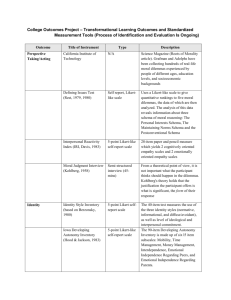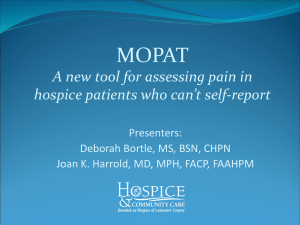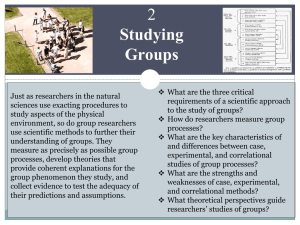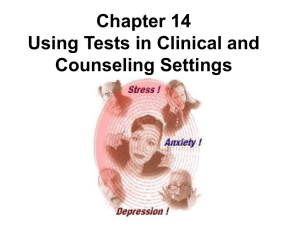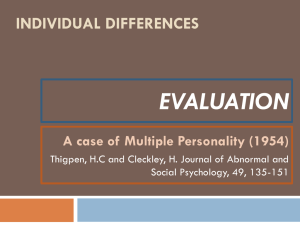Relationship Between Self-report and Objective Physical
advertisement
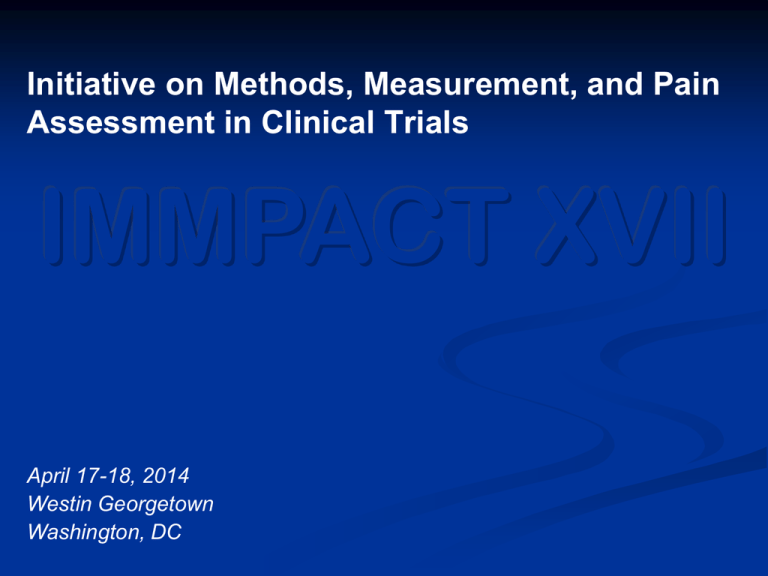
Initiative on Methods, Measurement, and Pain Assessment in Clinical Trials IMMPACT XVII April 17-18, 2014 Westin Georgetown Washington, DC Housekeeping The meeting room does not have internet access. Please silence your cell phones. Microphones: microphones are voice-activated, please speak directly into the microphone. Today’s lunch will be held in the Promenade located on the lobby level. Check-out is at 12:00 Noon on Friday. Please check-out by 12:00 Noon and you may check your luggage at the bell stand or place in the back of the meeting room. Restrooms are located outside of the meeting room to the left. For departures to the airport or train station, taxis will be available in front of the hotel. Please consider sharing taxis. If you need any assistance please stop by the registration desk located outside of the meeting room. Interpreting the Clinical Importance of Improvements in Patient-reported and “Objective” Assessments of Physical Function Daniel J. Clauw M.D. dclauw@umich.edu Professor of Anesthesiology, Medicine (Rheumatology), and Psychiatry Director, Chronic Pain and Fatigue Research Center The University of Michigan Disclosures ■ Consulting ■ Pfizer, Forest, Eli Lilly, Pierre Fabre, Cypress Biosciences, Wyeth, UCB, Astra Zeneca, Merck, J & J, Nuvo, Jazz, Abbott, Cerephex, Iroko, Tonix, Theravance ■ Research support ■ Pfizer, Cypress Biosciences, Forest, Merck, Nuvo, Cerephex ■ One-time licensing fee paid to University of Michigan by Eli Lilly Relationship Between Self-report and Objective Physical Function ■ How strong is the relationship between self-report and objective measures of physical function in healthy individuals or in individuals with disease? ■ In studies that directly compare self-report and objective measures of physical function or functional status, what are the self-report measures really measuring? ■ Should we expect a strong relationship between self-report and objective measures? Lessons from other domains ■ Given the differences between self-report and objective measures, which is the “right” measure? Relationship Between Self-report and Objective Physical Function ■ How strong is the relationship between self-report and objective measures of physical function in healthy individuals or in individuals with disease? ■ In studies that directly compare self-report and objective measures of physical function or functional status, what are the self-report measures really measuring? ■ Should we expect a strong relationship between self-report and objective measures? Lessons from other domains ■ Given the differences between self-report and objective measures, which is the “right” measure? Not very ■ If we use actigraphy as the current gold standard for measuring activity or function in real life settings . . . ■ There is a consistently poor relationship (r = 0 - .40) between average activity levels and measures of functional status or activity.1-4 ■ There is a strong trend towards these relationships being stronger (albeit still rather weak) when the objective measure is compared to activity measures vs. functional status measures. 1) Kashikar-Zuck, et. al. Arthritis Care and Research 2013, 2) Chandonnet et. al. PLoS One 2012, 3) Ferriolli et. al. J Pain and Symptom Management 2012. 4) Evenson et. al. J Phys Act Health 2012. Relationship Between Self-report and Objective Physical Function ■ How strong is the relationship between self-report and objective measures of physical function in healthy individuals or in individuals with disease? ■ In studies that directly compare self-report and objective measures of physical function or functional status, what are the self-report measures really measuring? ■ Should we expect a strong relationship between self-report and objective measures? Lessons from other domains ■ Given the differences between self-report and objective measures, which is the “right” measure? Relationship between symptoms, selfreported, and objective measures of activity, in fibromyalgia ■ Patients with FM have amongst the lowest selfreported functional status of any chronic illness ■ This parameter has been very difficult to improve in interventional studies ■ How is self-reported activity related to: ■ Objective measures of activity ■ Specific symptoms Kop et. al. Arthritis Rheum 2005 Measuring Symptoms and Activity Simultaneously ■ Ecological Momentary Assessment (EMA) (Stone & Shiffman, 1994) symptoms in ‘real-time’ ■ Audible prompts ■ Obtains time-stamped recordings ■ ■ Actigraphy ■ Actiwatch-S (Mini Mitter, Bend, OR) ■ Omni-directional accelerometer ■ Records intensity of movement as activity counts Actogram I Running Preparing dinner Walking Getting ready In bed; reading Office work-desk Sleeping Swimming Got up Office work-desk Couch sitting; reading Walking Methods / Subjects ■ Thirty patients with FM (mean age=41.5) were compared with 29 sedentary control participants (mean age=38.9). ■ Actigraphs were worn for 5 consecutive days and four consecutive nights. Activity levels were sampled over 5 min epochs. Participants rated symptoms ("pain", "tired", "stressed") on 10-point scales 5 times/day based on actigraph-driven alerts. Results – Objective Activity ■ Average daytime and nighttime activity levels were nearly identical in the patient and the control groups (p=ns). Patients Controls Daytime Nighttime PCS 1456429 1445556 147156 152107 36 56 Peak Activity ■ Peak activity was significantly lower in the FM patient group relative to the control group (p=0.008). ■ 7870 3223 vs. 12178 7862 activity units ■ Variability of peak activity was also significantly different between groups ■ Levene’s test on SDs, p=0.001 Average and Diurnal Peak Activity Levels of Fibromyalgia Compared to Controls 14000 * * Control Fibromyalgia Units (Activity) 12000 * * 10000 8000 6000 4000 Morning *p<0.05; Error Bars=SEM Mid-Morning Afternoon Evening Actograms FM patient Days of higher activity followed by days of less activity Control Higher peak activity, less sporadic Assessment of Pain and Activity in a Placebo-Controlled Crossover Trial of Celecoxib in Osteoarthritis of the Knee ■ RCT in OA (n=47) to examine how to better differentiate active treatment from placebo ■ The WOMAC pain subscale was the most responsive of all five pain measures. ■ Pain–activity composites resulted in a statistically significant difference between celecoxib and placebo but were not more responsive than pain measures alone. However, a composite responder defined as having 20% improvement in pain or 10% improvement in activity yielded much larger differences Trudeau et. al. Pain Practice 2014 Assessment of Pain and Activity in a Placebo-Controlled Crossover Trial of Celecoxib in Osteoarthritis of the Knee ■ The most responsive actigraphy measure was peak activity, with a between-group difference of 91.9 counts/min (P = 0.090); mean activity and total activity did not approach statistical significance. ■ Actigraphy was more responsive than the WOMAC function scale, possibly due to lower placebo responsiveness. Trudeau et. al. Pain Practice 2014 Relationship Between Self-report and Objective Physical Function ■ How strong is the relationship between self-report and objective measures of physical function in healthy individuals or in individuals with disease? ■ In studies that directly compare self-report and objective measures of physical function or functional status, what are the self-report measures really measuring? ■ Should we expect a strong relationship between self-report and objective measures? Lessons from other domains ■ Given the differences between self-report and objective measures, which is the “right” measure? Self-report vs. Objective Measures of Other Domains ■ Sleep ■ Correlation between multiple PSG measures and multiple self-report measures in sleep apnea patients ranges from r = .01-.24, mean r = .09.1 ■ Correlations between self-report and PSG measures in insomnia r = .05 - .36.2 ■ Memory/cognition ■ Very poor relationship between subjective measures and objective performance based measures in both healthy individuals, and individuals with mild TBI, but there is a modest relationship between subjective measures and mood measures.3,4 1) Weaver, Arch Otolaryngol Head Neck, 2004. 2) Bastien et. al. Sleep Medicine 2001. 3) Schliesher J Clin Exp Neuropsych, 2011. 4) Spencer et. al. JRRD, 2010. Relationship Between Self-report and Objective Physical Function ■ How strong is the relationship between self-report and objective measures of physical function in healthy individuals or in individuals with disease? ■ In studies that directly compare self-report and objective measures of physical function or functional status, that are the self-report measures really measuring? ■ Should we expect a strong relationship between self-report and objective measures? Lessons from other domains ■ Given the differences between self-report and objective measures, which is the “right” measure? I’ll put my money on the objective measures as an “anchor” ■ As Kushang Patel presented yesterday, these measures have become very accurate and reliable measures of what a person is actually doing ■ Susan Murphy’s studies in OA1-3 have been very informative (i.e. surprising) in examining the relationship between actigraphy and pain and other symptoms that can help us identify differing endo-phenotypes ■ Within an OA cohort, there are markedly different patterns of contingencies between pain and activity (in some people activity makes pain worse, others better) and in many individuals fatigue is much more related to inactivity than pain 1) Murphy SL, Arthritis Care Res (Hoboken), 2011. 2) Murphy SL et. al. Arthritis Res Ther. 2011. 3) Murphy SL, et. al. Current Rheumatology Reports, 2012. Summary ■ Even though there is good evidence that actigraphy is an accurate measure of physical activity and has high reliability, there is a consistently poor (r = 0 - .40) relationship between these measures and subjective measures ■ There is generally a better (but still very modest) relationship between actigraphy and subjective measures of activity vs. function ■ Peak activity levels on actigraphy relate more closely to subjective functional status measures than average activity ■ These disparate results between subjective and objective activity measures are not confined to pain patients (also seen in healthy individuals) and not confined to objective vs subjective measures of physical function Initiative on Methods, Measurement, and Pain Assessment in Clinical Trials IMMPACT XVII April 17-18, 2014 Westin Georgetown Washington, DC


